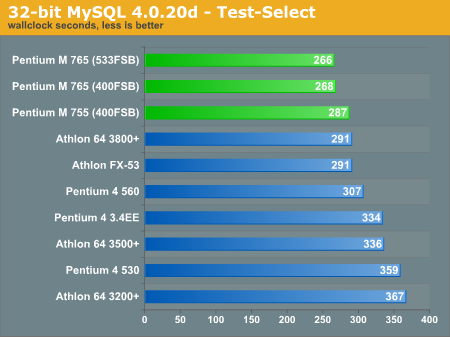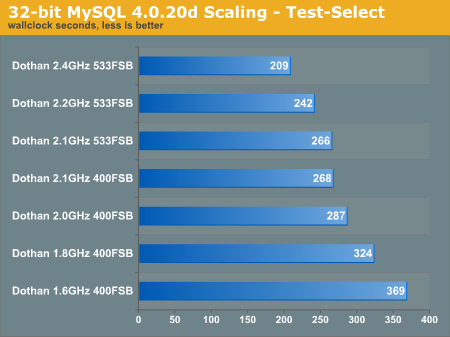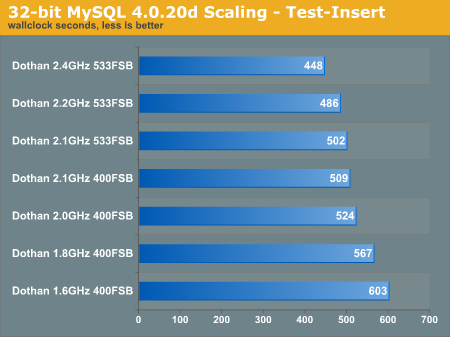Linux and the Desktop Pentium M: Uncommon Performance
by Kristopher Kubicki on December 24, 2004 12:00 PM EST- Posted in
- Linux
Database Tests
MySQL 4.0.20d has been a staple of our Linux tests since its inception. Even though it does not carry high relevance for a workstation test, we still regard it as the de facto free, open sourced benchmark for Linux. Below, you can see our results for sql-bench on both the 32-bit kernel for SuSE 9.1.

Our first benchmark with Pentium M seems almost too good to be true. Just to verify that our results are sane, we re-ran the same tests with several different multipliers set on the Dothan 2.1GHz.


Surprisingly, things look very favorable for Pentium M thus far. However, this is a mildly synthetic benchmark and it may not represent real world use as closely as many of our other benchmarks do. As you can see, we overclocked and underclocked the processor a little bit just to get a feel of what our Pentium M is capable of. Many of our database performance tests in the past have shown that Xeons with additional L3 cache out-perform Xeons without extra cache. So, we might be safe to assume that the 2MB L2 cache on the Pentium M is what gives the Dothan the additional boost. To date, the Dothan has more L2 cache than any other processor that we have seen.










47 Comments
View All Comments
Adul - Friday, December 24, 2004 - link
stephenbrooks "superlinearly" even a word? Though I do understand what you mean.KristopherKubicki - Friday, December 24, 2004 - link
abakshi: Intel roadmaps say only DDR1 for 915GL.Kristopher
stephenbrooks - Friday, December 24, 2004 - link
The Pentium M scales superlinearly with frequency in a few of the time vs. clock-speed benches (and I'm not talking about the 400->533 FSB improvement), which is pretty interesting. I wouldn't have expected a chip like this to get more efficient at _higher_ clocks.abakshi - Friday, December 24, 2004 - link
Well FSB533 is here, but 800 would be a more significant move with Dothan. A P-M with FSB800, even DDR400 let's say (rather than the DDR2 that should be supported by using a 915 northbridge), and higher clockspeeds - maybe about 2.4-2.6 Ghz - would be amazing.Linux performance will of course depend on other factors such as those mentioned in the article, but the performance under Windows of even the FSB400 2.0 Dothan is awesome -- when overclocked to 2.4Ghz, it's able to keep up with, and at times beat, the latest P4 Prescott and EE's, and A64's, for tasks like gaming:
http://www.gamepc.com/labs/view_content.asp?id=dot...
http://translate.google.com/translate?hl=en&sl...
Lonyo - Friday, December 24, 2004 - link
If Intel gave it a FSB and memory speed boost (ie: 533MHz or 800MHz FSB) and DDR533+, then Dothan could really be something.With Intels talk of dual core processors, a dual core Dothan, with its low heat output, would be awesome (but costly with 2MB of cache).
2x30w = 60w = less than Prescott.
It looks promising, if only Intel would bring it to the affordable desktop :(
VortigernRed - Friday, December 24, 2004 - link
"Although it holds up well against an Athlon 64 3200+,"Although the Dothan looks to be a superb chip you are certainly overstating its performance here, this is comment is WRT the Shake benchmarks and, effectively, the A64 3200 is twice as fast as the dothan. This would be like saying, for example, a R9800XT holds up well against an X800XT or an AXP2200+ holds up well against a A64 3800+ :-)
Also whilst the DDR400 does improve performance it can't help the Dothan where it is really far behind, the kernel compile benchmarks, for instance, it is still 3x slower than any of the other chips on the chart.
Dothan (or really its derivatives) have loads of potential to compete with the A64 on all fronts (Performance, power, heat, with Intels manufacturing, even cost) given enough effort by Intel (which I'm sure they are doing). I can hardly wait to see widespread adoption on the desktop and, frankly, to see the back of the P4. A desktop Celeron PM (1MB l2, lower FSB) could be the new overclocking king.
bersl2 - Friday, December 24, 2004 - link
You might want to ask on the GCC mailing lists (http://gcc.gnu.org/lists.html) about --march=pentium-m.